When it comes to strength training, “subtle” isn’t typically a word that comes to mind. Rather, we often think of it as big, loud, or powerful.
But as generations of Eastern martial artists have demonstrated, outwardly gentle movement — performed quietly and with intense focus — can also help us develop a strength potential we may not realize we have.
Practicing qigong is one way to access this inner strength. Qigong (pronounced “chee-GUNG”) integrates movement exercises, controlled breathing, and meditation. (Learn more at “Go With the Flow: The Qigong Workout.”)
Silk Reeling Spiral Power Qigong is one of many forms with roots dating back 4,000 years in China. Also known simply as “silk reeling,” this integrative practice brings together the body’s seemingly disparate parts.
The effect is physically and mentally grounding, says Mela Carreira, a longtime martial artist and instructor at the Tao Institute in Asheville, N.C.
Silk reeling “can enhance just about any sport, but it’s especially good for sports where rooting and grounding is important,” she says.
This includes martial arts but translates to activities as diverse as running, deadlifting, and yoga.
What makes silk reeling special is its focus on the internal “spiral” of energy that practitioners believe resides in each person. According to practitioners, the spiral originates in the area from the middle of your torso to your upper thigh, and when it’s engaged, it flows throughout your entire body.
If this spiral is unobstructed, the result is energy and vitality in movement and spirit.
But spiral power can be blocked as a result of a sedentary lifestyle. Just imagine the energy drain you feel after spending hours seated behind your desk or doing “nothing” when you get home from work.
Certain movement patterns tap into the spiral, says Carreira, who credits the silk-reeling practice with improving her own movement patterns. She says silk reeling has helped build what she refers to as “subtle strength,” benefiting both her martial-arts practice and daily life.
“In many ways, I am stronger than I used to be just from doing spiral power work,” she says.
Carreira and Sifu (certified martial-arts master) Frank Paolillo designed the following workout to strengthen your tendons and ligaments, build balance and body awareness, correct alignment, improve posture, and boost vitality. The moves are also effective for helping you feel grounded during hectic moments, says Carreira.
With practice, she explains, you’ll feel your feet connecting all the way to your head, leading to full-body integration while you’re exercising and moving through normal daily activities.
The Workout
These movements can be used as a daily routine. Some people like to practice them in the morning to put themselves in a centered place to start their day.
Workout designers Mela Carreira and Frank Paolillo have suggested reps, but it’s perfectly fine to do as few or as many as desired, or to just pick one or two exercises to work on rather than the entire set.
For each exercise, keep your knees slightly bent, and gently place your tongue on the roof of your mouth (behind but not touching your teeth) — this is believed to help improve energy flow. Breathe through the nose and deeply into the lower abdomen.
Cleansing
This movement helps you connect your body with the earth and feel centered as you start your practice.
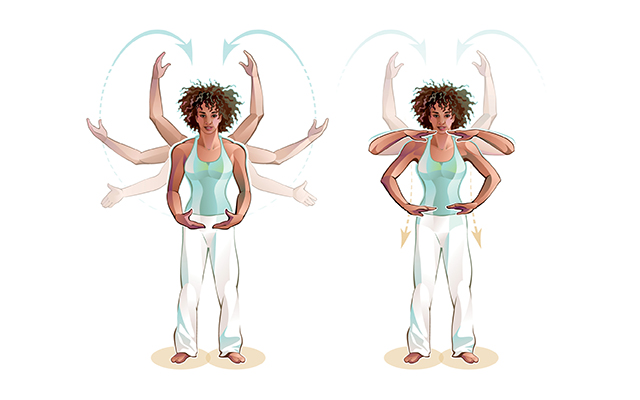
- Begin with your feet shoulder width apart and your knees slightly bent. Form a circle with your arms, as if embracing your lower abdomen about three fingers below your belly button. Take a deep breath, and think about rooting your feet down into the floor.
- With your feet rooted, inhale deeply, and slowly reach your hands up toward the sky in a circular motion.
- As you exhale, slowly press the palms down toward the earth in front of your body, with your thumbs facing your body.
- Finish with your hands all the way down at your lower abdomen again, facing your palms toward the floor as they drop.
- Repeat three times.
Picking Fruit
This reaching movement connects your entire side body, extending from feet to hands, while also incorporating rotation at the waist and grounding you into the earth.
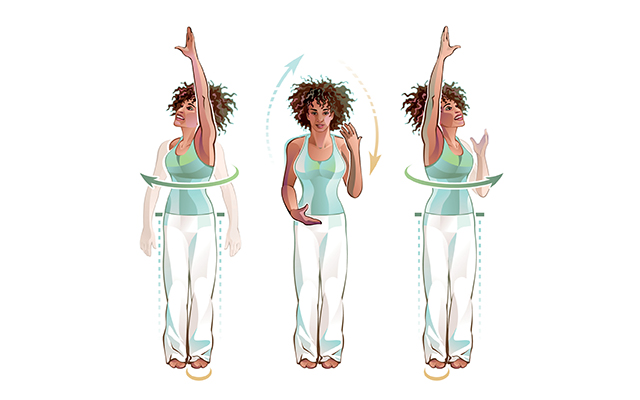
- Bring your feet together while maintaining a slight bend in your knees.
- Rotating to your right from the waist, reach up with your left hand, as if you are picking a piece of fruit above your head. Make sure you are using your entire body, and feel the connection from your left foot to your left hand as you extend. Don’t move your feet.
- Bring your left hand down, and repeat on the right.
- Alternate for a total of eight times per side.
Circling Shoulders
Stay relaxed during this move to integrate your entire body.
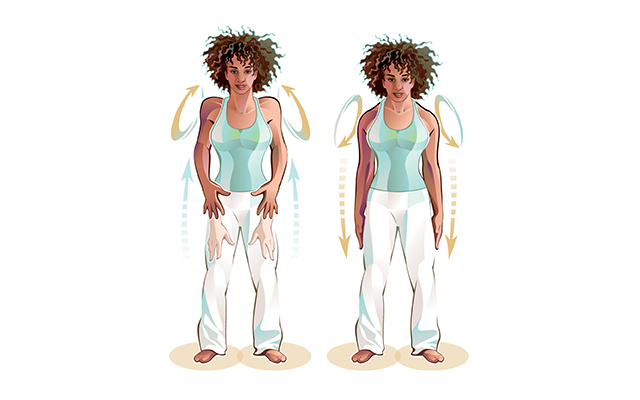
- Begin with your feet shoulder width apart and a slight bend in your knees.
- Draw your shoulders up and circle them back, allowing your hands to run across your thighs.
- Roll your shoulders back and down, and drop your hands to the side of your body.
- Repeat eight times.
- Reverse the movement to roll your shoulders forward eight times.
Circling Knees
This simple exercise helps keep your knees loose and agile.
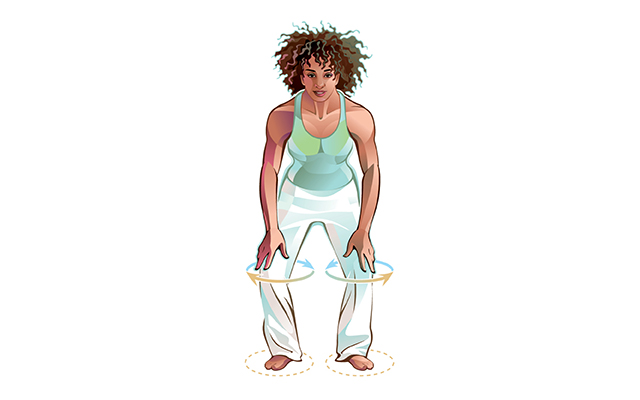
- Begin with your feet shoulder width apart.
- Bend slightly at the waist and knees, and place your hands on your knees.
- Circle your knees outward around your ankles, making sure not to let your knees extend past your toes.
- Repeat eight times.
- Reverse directions, circling inward for eight repetitions.
Full-Body Spiraling
This movement opens up your joints and relaxes all of your muscles. It also teaches full-body integration and allows you to engage your tendons and ligaments rather than relying on purely muscular strength.
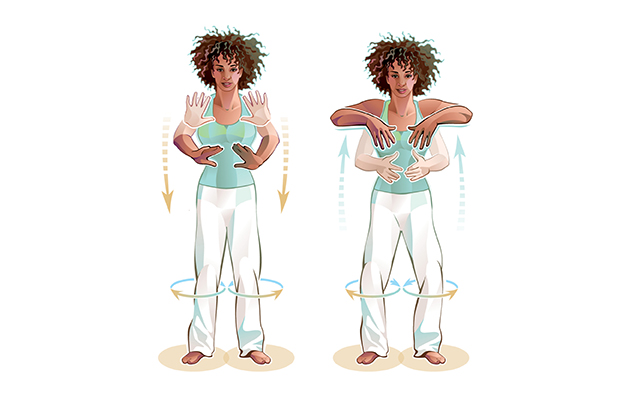
- With your palms facing away from you, begin by circling your hands in an outside circle in opposite directions. Incorporate your arms by gently circling your elbows and shoulders, raising and lowering your arms with the movement.
- Meanwhile, circle your knees slightly outward, taking care not to move your knees past your toes.
- Repeat eight times.
- Reverse to turn your knees and hands inward for eight repetitions.
Bending and Lifting
This movement helps improve knee-joint stability, teaches you to be relaxed while bending, helps you develop spring power in your legs, and teaches you how to lift things without hurting yourself.
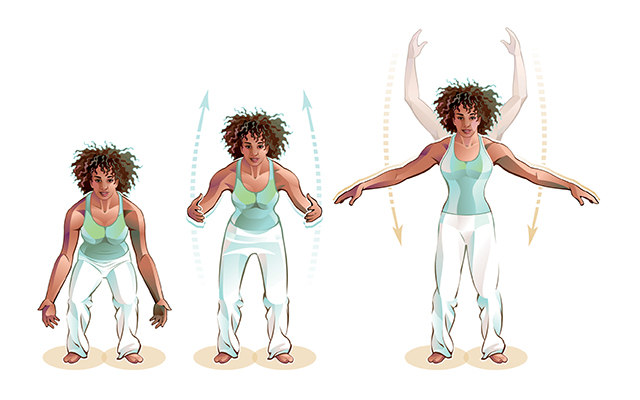
- Bending at your knees and waist, squat down as far as you comfortably can, but not farther than thighs parallel to the floor. Make sure your knees do not extend past your toes and that your spine is straight.
- Staying rooted through your feet, inhale deeply and lift your arms in front of your body with your fingers naturally extended (not stretched out or limp), until your arms are over your head.
- On the descent, slowly lower your arms to your side while exhaling. Feel yourself sinking down into the earth.
- Return to your starting position.
- Repeat eight times.
Horse-Stance Circles
This exercise helps alleviate tension in your hips and improve your posture, as well as open up energy in your lower body.

- Assume a wide stance, keeping your feet close to parallel.
- Maintaining a neutral pelvis and upright posture, squat as deeply as you comfortably can, aiming to get thighs parallel to the ground.
- Start with your elbows bent and the backs of your hands touching in front of you.
- Inhale as you extend your hands overhead, allowing your shoulders to rotate so your hands face each other and fingertips lightly touch at the top. Then drop your arms slowly to your sides.
- Keeping your back straight, repeat eight times.
- Reverse the circle, and repeat with your fingers pointing down as you lower your hands in front of your body, and lift your arms up.
- Repeat eight times.
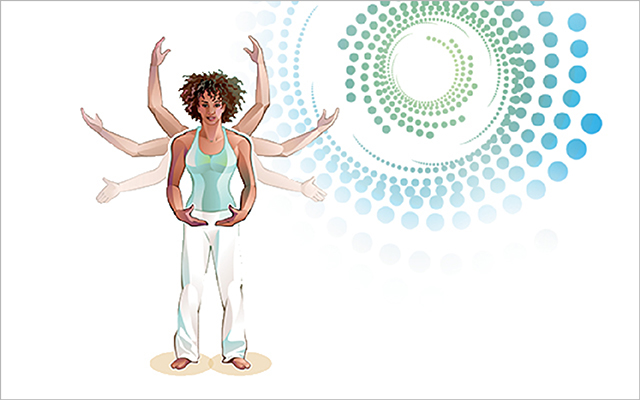
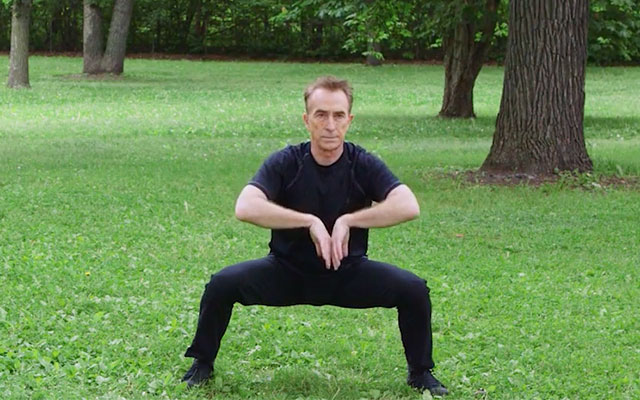
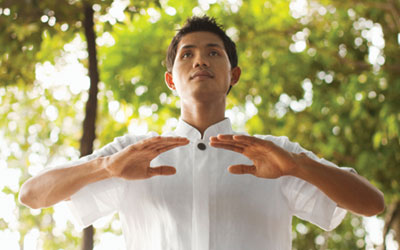
This Post Has 0 Comments